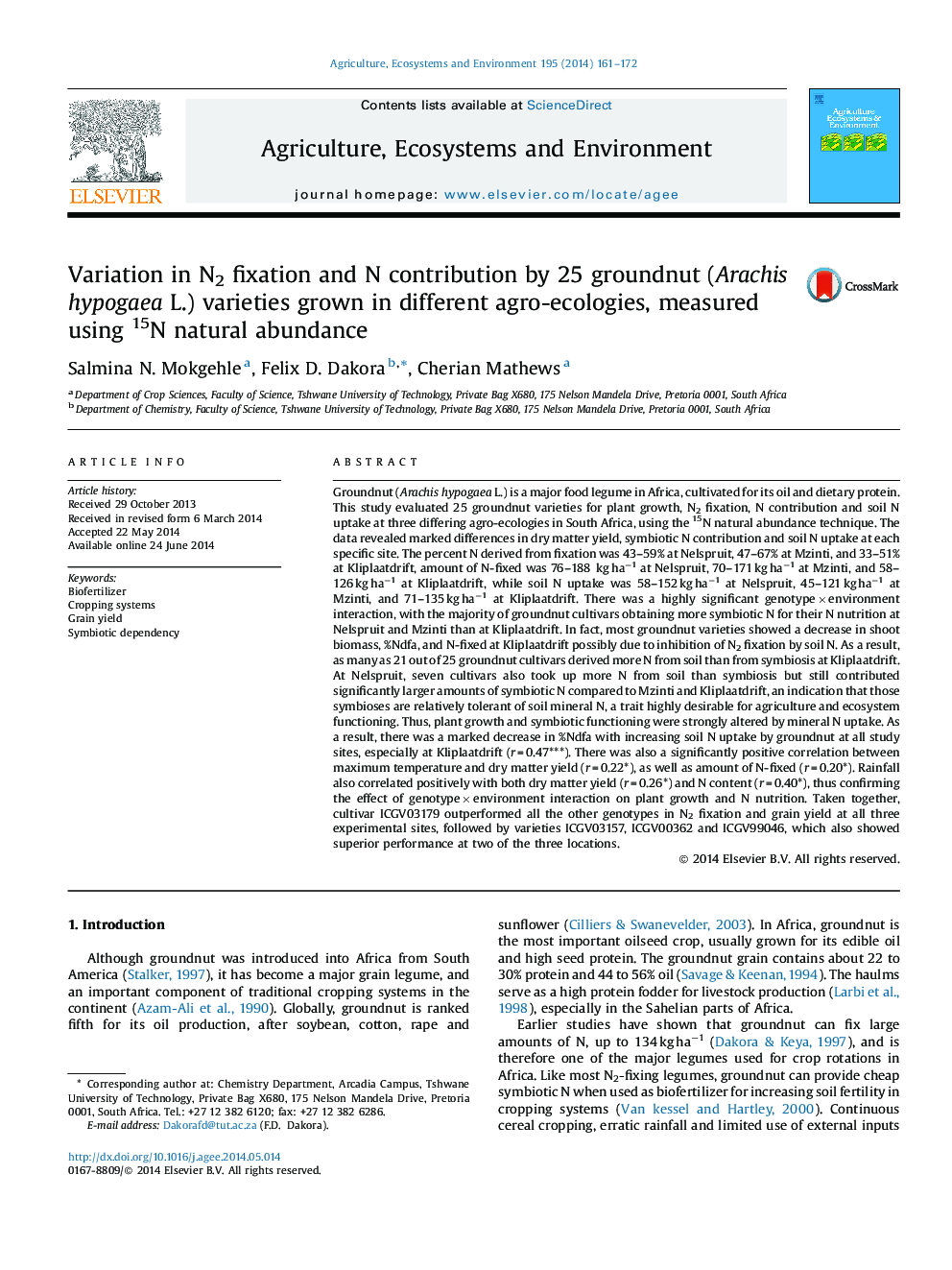| کد مقاله | کد نشریه | سال انتشار | مقاله انگلیسی | نسخه تمام متن |
|---|---|---|---|---|
| 2413919 | 1552057 | 2014 | 12 صفحه PDF | دانلود رایگان |

• Our study revealed large differences in plant growth, symbiotic performance and soil N uptake.
• Recorded differences between dry matter yield and amount of N-fixed indicated that temperature between the sites altered plant growth and N2 fixation.
• Results revealed that in addition to soil; N, rainfall and maximum temperature differed between the sites, and they too could, in part, account for the observed differences in plant performance.
• Our study showed positive correlations between dry matter and pod yield at Mzinti, Kliplaatdrift and Nelspruit; and again dry matter yield, %Ndfa, and δ15N with soil N uptake indicating that plant growth and symbiotic functioning was strongly affected by mineral N uptake in groundnut.
Groundnut (Arachishypogaea L.) is a major food legume in Africa, cultivated for its oil and dietary protein. This study evaluated 25 groundnut varieties for plant growth, N2 fixation, N contribution and soil N uptake at three differing agro-ecologies in South Africa, using the 15N natural abundance technique. The data revealed marked differences in dry matter yield, symbiotic N contribution and soil N uptake at each specific site. The percent N derived from fixation was 43–59% at Nelspruit, 47–67% at Mzinti, and 33–51% at Kliplaatdrift, amount of N-fixed was 76–188 kg ha−1 at Nelspruit, 70–171 kg ha−1 at Mzinti, and 58–126 kg ha−1 at Kliplaatdrift, while soil N uptake was 58–152 kg ha−1 at Nelspruit, 45–121 kg ha−1 at Mzinti, and 71–135 kg ha−1 at Kliplaatdrift. There was a highly significant genotype × environment interaction, with the majority of groundnut cultivars obtaining more symbiotic N for their N nutrition at Nelspruit and Mzinti than at Kliplaatdrift. In fact, most groundnut varieties showed a decrease in shoot biomass, %Ndfa, and N-fixed at Kliplaatdrift possibly due to inhibition of N2 fixation by soil N. As a result, as many as 21 out of 25 groundnut cultivars derived more N from soil than from symbiosis at Kliplaatdrift. At Nelspruit, seven cultivars also took up more N from soil than symbiosis but still contributed significantly larger amounts of symbiotic N compared to Mzinti and Kliplaatdrift, an indication that those symbioses are relatively tolerant of soil mineral N, a trait highly desirable for agriculture and ecosystem functioning. Thus, plant growth and symbiotic functioning were strongly altered by mineral N uptake. As a result, there was a marked decrease in %Ndfa with increasing soil N uptake by groundnut at all study sites, especially at Kliplaatdrift (r = 0.47***). There was also a significantly positive correlation between maximum temperature and dry matter yield (r = 0.22*), as well as amount of N-fixed (r = 0.20*). Rainfall also correlated positively with both dry matter yield (r = 0.26*) and N content (r = 0.40*), thus confirming the effect of genotype × environment interaction on plant growth and N nutrition. Taken together, cultivar ICGV03179 outperformed all the other genotypes in N2 fixation and grain yield at all three experimental sites, followed by varieties ICGV03157, ICGV00362 and ICGV99046, which also showed superior performance at two of the three locations.
Journal: Agriculture, Ecosystems & Environment - Volume 195, 1 October 2014, Pages 161–172